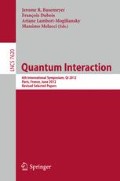Abstract
We have recently elaborated Quantum Model Theory (QMod) to model situations where the quantum effects of contextuality, interference, superposition, entanglement and emergence, appear independently of the microscopic nature of the entities giving rise to these situations. We have shown that QMod models without introducing linearity for the set of the states. In this paper we prove that QMod, although not using linearity for the state space, provides a method of identification for entangled states and an intuitive explanation for their occurrence. We illustrate this method for entanglement identification with concrete examples.
Access this chapter
Tax calculation will be finalised at checkout
Purchases are for personal use only
Preview
Unable to display preview. Download preview PDF.
References
Aerts, D., Sozzo, S.: Quantum Model Theory (QMod): Modeling Contextual Emergent Entangled Interfering Entities. In: Busemeyer, J.R., Dubois, F., Lambert-Mogiliansky, A. (eds.) QI 2012. LNCS, vol. 7620, pp. 126–137. Springer, Heidelberg (2012)
Aerts, D.: Quantum Structure in Cognition. J. Math. Psych. 53, 314–348 (2009)
Aerts, D.: Quantum Particles as Conceptual Entities: A Possible Explanatory Framework for Quantum Theory. Found. Sci. 14, 361–411 (2010)
Aerts, D.: Interpreting Quantum Particles as Conceptual Entities. Int. J. Theor. Phys. 49, 2950–2970 (2010)
Aerts, D.: A Potentiality and Conceptuality Interpretation of Quantum Physics. Philosophica 83, 15–52 (2010)
Aerts, D.: Being and Change: Foundations of a Realistic Operational Formalism. In: Aerts, D., Czachor, M., Durt, T. (eds.) Probing the Structure of Quantum Mechanics: Nonlinearity, Nonlocality, Probability and Axiomatics, pp. 71–110. World Scientific, Singapore (2002)
Gabora, L., Aerts, D.: Contextualizing Concepts Using a Mathematical Generalization of the Quantum Formalism. J. Exp. Theor. Art. Int. 14, 327–358 (2002)
Aerts, D., Gabora, L.: A Theory of Concepts and Their Combinations I: The Structure of the Sets of Contexts and Properties. Kybernetes 34, 167–191 (2005)
Aerts, D., Gabora, L.: A Theory of Concepts and Their Combinations II: A Hilbert Space Representation. Kybernetes 34, 192–221 (2005)
Gabora, L.: Cultural Evolution Entails (Creativity Entails (Concept Combination Entails Quantum Structure)). In: Bruza, P., Lawless, W., van Rijsbergen, K., Sofge, D. (eds.) Proceedings of the Association for the Advancement of Artificial Intelligence (AAAI) Spring Symposium 8: Quantum Interaction, March 26-28, pp. 106–113. Stanford University, Stanford (2007)
Nelson, D.L.: Entangled Associative Structures and Context. In: Bruza, P., Lawless, W., van Rijsbergen, K., Sofge, D. (eds.) Proceedings of the Association for the Advancement of Artificial Intelligence (AAAI) Spring Symposium 8: Quantum Interaction, March 26-28. Stanford University, Stanford (2007)
Gabora, L., Rosch, E., Aerts, D.: Toward an Ecological Theory of Concepts. Ecol. Psych. 20, 84–116 (2008)
Flender, C., Kitto, K., Bruza, P.: Beyond Ontology in Information Systems. In: Bruza, P., Sofge, D., Lawless, W., van Rijsbergen, K., Klusch, M. (eds.) QI 2009. LNCS, vol. 5494, pp. 276–288. Springer, Heidelberg (2009)
Gabora, L., Aerts, D.: A Model of the Emergence and Evolution of Integrated Worldviews. J. Math. Psych. 53, 434–451 (2009)
D’Hooghe, B.: The SCOP-formalism: An Operational Approach to Quantum Mechanics. In: AIP Conference Proceedings, vol. 1232, pp. 33–44 (2010)
Aerts, D., Czachor, M., Sozzo, S.: A Contextual Quantum-based Formalism for Population Dynamics. In: Proceedings of the AAAI Fall Symposium (FS-10-08), Quantum Informatics for Cognitive, Social, and Semantic Processes, pp. 22–25 (2010)
Veloz, T., Gabora, L., Eyjolfson, M., Aerts, D.: Toward a Formal Model of the Shifting Relationship between Concepts and Contexts during Associative Thought. In: Song, D., Melucci, M., Frommholz, I., Zhang, P., Wang, L., Arafat, S. (eds.) QI 2011. LNCS, vol. 7052, pp. 25–34. Springer, Heidelberg (2011)
Aerts, D., Sozzo, S.: Quantum Structure in Cognition: Why and How Concepts Are Entangled. In: Song, D., Melucci, M., Frommholz, I., Zhang, P., Wang, L., Arafat, S. (eds.) QI 2011. LNCS, vol. 7052, pp. 116–127. Springer, Heidelberg (2011)
Aerts, D.: A Possible Explanation for the Probabilities of Quantum Mechanics. J. Math. Phys. 27, 202–210 (1986)
Aerts, D.: Quantum Structures due to Fluctuations of the Measurement Situations. Int. J. Theor. Phys. 32, 2207–2220 (1993)
Aerts, D.: Quantum Structures, Separated Physical Entities and Probability. Found. Phys. 24, 1227–1259 (1994)
Aerts, D.: Quantum Structures: An Attempt to Explain Their Appearance in Nature. Int. J. Theor. Phys. 34, 1165–1186 (1995)
Aerts, D., Aerts, S.: The Hidden Measurement Formalism: Quantum Mechanics as a Consequence of Fluctuations on the Measurement. In: Ferrero, M., van der Merwe, A. (eds.) New Developments on Fundamental Problems in Quantum Physics, pp. 1–6. Springer, Dordrecht (1997)
Aerts, D., Aerts, S., Coecke, B., D’Hooghe, B., Durt, T., Valckenborgh, F.: A Model with Varying Fluctuations in the Measurement Context. In: Ferrero, M., van der Merwe, A. (eds.) New Developments on Fundamental Problems in Quantum Physics, pp. 7–9. Springer, Dordrecht (1997)
Aerts, D., Aerts, S., Durt, T., Lévêque, O.: Classical and Quantum Probability in the ε-model. Int. J. Theor. Phys. 38, 407–429 (1999)
Aerts, S.: Hidden Measurements from Contextual Axiomatics. In: Aerts, D., Czachor, M., Durt, T. (eds.) Probing the Structure of Quantum Mechanics: Nonlinearity, Nonlocality, Probability and Axiomatics, pp. 149–164. World Scientific, Singapore (2002)
Aerts, S.: The Born Rule from a Consistency Requirement on Hidden Measurements in Complex Hilbert Space. Int. J. Theor. Phys. 44, 999–1009 (2005)
Aerts, S.: Quantum and Classical Probability as Bayes-optimal Observation (2006), http://uk.arxiv.org/abs/quant-ph/0601138
Aerts, D.: Example of a macroscopical situation that violates Bell inequalities. Lettere al Nuovo Cimento 34, 107–111 (1982)
Aerts, D.: A mechanistic classical laboratory situation violating the Bell inequalities with 2\(\sqrt{2}\), exactly ‘in the same way’ as its violations by the EPR experiments. Helvetica Physica Acta 64, 1–23 (1991)
Author information
Authors and Affiliations
Editor information
Editors and Affiliations
Rights and permissions
Copyright information
© 2012 Springer-Verlag Berlin Heidelberg
About this paper
Cite this paper
Aerts, D., Sozzo, S. (2012). Entanglement of Conceptual Entities in Quantum Model Theory (QMod). In: Busemeyer, J.R., Dubois, F., Lambert-Mogiliansky, A., Melucci, M. (eds) Quantum Interaction. QI 2012. Lecture Notes in Computer Science, vol 7620. Springer, Berlin, Heidelberg. https://doi.org/10.1007/978-3-642-35659-9_11
Download citation
DOI: https://doi.org/10.1007/978-3-642-35659-9_11
Publisher Name: Springer, Berlin, Heidelberg
Print ISBN: 978-3-642-35658-2
Online ISBN: 978-3-642-35659-9
eBook Packages: Computer ScienceComputer Science (R0)

